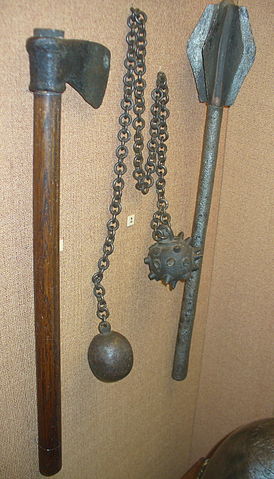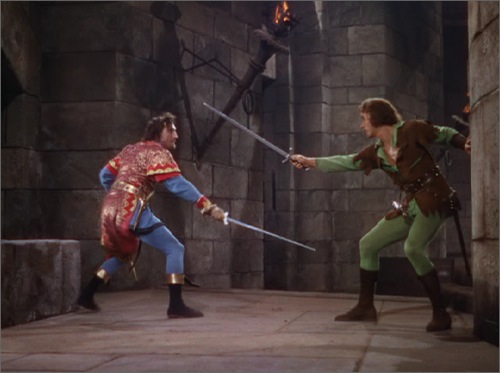You probably have a high idea of swords. You think they are noble, knightly, honorable or something. Like many book readers, movie enthusiasts, gamers. Like many people who like period movies like Robin Hood, Three Musketeers, medieval stuff and whatnot.
That fast, witty, heroic – rogue like – characters use swords to deliver fast sword plays to outdo dastardly opponents, while delivering witty remarks. In games, swords are depicted as the agile, poetic and merry characters’ weapon. Or, the sly rogue’s. And that’s the perception you have of swords. And its wrong.
Not your fault.
Subscribe to Quantum Joystick Here:
(you will also get updates when a new posts are out)
In games, movies, period drama, literature – practically every medium, swords are depicted as such. Its natural that people come to perceive them like that.
But the reality is that, swords were totally different and served a totally untold purpose.
Useless in Warfare
Yeah. You heard right.
Swords were useless for warfare. Especially in middle ages, the era in which they are depicted to be a staple of warfare.
Swords are cutting devices. Therefore they need to be able to cut the target they are used on. Now, pay attention to this ‘cutting device’ remark – it will be very important in just a little bit.
So, swords needed to cut to be effective. For, if you use them only for stabbing, almost 90% of the point of using a cutting weapon goes away, wouldn’t it?
But what can you ‘cut’ in a battlefield in which people are laden with varying degrees of armor, with the weakest armor being thick leather or heavy tribal clothing? Chainmail, plate mail (later periods), ring mail and all versions of metal armor is out of the question. For even if you can harm your opponent in certain unprotected locations, you need to be very swift, agile and lucky to do that, and spend considerable time to get results.
In the chaos of a battlefield there are no such things. Someone will bash your head in before you can do anything like that.
But lets say that you can be effective with a sword against some segment of the opponents. Very weakly armored, not well armed, close by. And assuming someone is not shoving a spear or a pike up your delicate parts.
Would it be sane to enter a battle with a weapon which is effective only against a certain segment of an opposing army? Leave aside ARMING an entire army or a certain segment of that army with swords?
It wouldn’t…

Naturally, the commonplace weapons found in most of middle ages were Spears and Axes. Things that have momentum and works with penetration – even if axe is a cutting device, it relies on heavy momentum. And most axes had piercing or thrusting additions on them.
And in later periods, Maces, mauls dominated the battlefield. And something very, very nasty and disturbing – the “Military Pick”.
As you can see, these are all devices designed to penetrate armor, overcome armor, bash in armor – everything is designed against armor. All of them are impact weapons.
There were some regions in which some swords like Bastard Swords or Claymore Swords were used for very short time periods. But as you can see, these are actually devices which work with impact – not much different than an axe. And instead of trying to swing such a thing around, it would be a much safer bet to use a mace or a military pick anyway. Not surprisingly, they weren’t used much or in abundance.
So, swords were useless in battle. Then, what were they used for, and why they were so widespread?
Repression
Remember that the sword was a cutting weapon?
Yeah.
With a sword, you can easily wound an opponent with multiple cuts, causing them to bleed and eventually having to surrender or pass out due to blood loss. That was why it was used so widely and for that long.
Guess whom used it and whom they used it against…
Aristocrats used them against everyone else.
Yeah.
No one could carry a sword, but an aristocrat. As per the law in most of Europe in throughout Middle Ages.
Serfs, Villagers, Common Folk, Freemen, Merchants, Blacksmiths – whomever you are, if you were not a noble, you couldn’t carry sword, well into the baroque era – leave aside middle ages.
Why was such a law necessary?
To prevent retaliation against aristocrats, to be able to repress reacting villages, to put down rebellions. In addition to defend themselves when they are out in the village or the city and the ‘rabble’ (aka, common people) get ‘rowdy’ – confronting or assaulting them. So much that French Aristocracy was widely carrying their swords around in the days leading up to French revolution.
In short, Repression…
Yeah, the so much beloved knightly weapon of literature, movies and games, was a rather disgusting tool for repression. Leaving aside the very concept of a ‘knight’ being an aristocrat which is permanently designated to enforce the aristocrat king’s will to the serfs under the knight’s direct aristocratic control – the very guy who suppresses the people at the bottom of the aristocracy ladder.
Takes a lot of the magic around the device, doesn’t it…
But why the different depiction?
Yeah the depiction of swords, how they are used, the people who use it are totally different in literature, movies and games.
But pay attention – those who use swords are predominantly aristocrats or ‘well to do’ people. Or, people who are of such origin, but have fallen into ‘hard times’. With ‘hard times’ being the normal usual desolate way their entire society lives.
Like Robin Hood – its so great a ‘wrongdoing’ him losing his ancestral castle, and having to live in a forest, surviving by hunting and wiping his ass to leaves.
Of course there are exceptions – in literature and in games too – especially in games. But games do not follow real history closely, in general – like Science Fiction.
So, its a dominant narrative in literature to portray swords as such honorable, knightly devices. Why is that so?
First, literature evolved mainly from aristocrat or well to do circles, and not only were written by them, but also written FOR them. Readership for early literature was mostly limited to upper classes in the early 17th and 18th centuries. You can’t depict yourself as repressing your loyal subjects, can you – even if that practice was one of ~200 years ago and more. For Baroque era and on it wasnt so easy to repress people via swords, but it was still used by nobles for self defense against the ‘rabble’ – aka ordinary people.
And then there are modern literary requirements – while writing a period piece, creating a character or more than one character to get the readership to like, you give them many attributes. “Honorable” and aristocrat or “aristocrat-like” attributes are among those.
You cant just give a brutal mace in the hand of a handsome, sharp looking bloke who is the main protagonist – you instead give him a sword, a ‘gentlemanly’ weapon which has a lot of connotations from nobility to selective due to its heritage.
You avoid the parts in which that noble protagonist needs to occasionally use that weapon to repress the undefended villagers so he can enjoy the luxuries he is having in his mansion with the feudal tribute from them…
And due to these an undeserved and totally fake impression of this repression-device was created through history of creative works in the past ~300 years – leave aside modern literature and narrative.
Next time you see a sword somewhere, think of a weapon which was used to wound hapless villagers into submission…
………………………..
Update: Here are a few resources to explain the narrative above:
http://www.medievalists.net/2014/12/07/top-10-weapons-middle-ages/
This short slide is very informative in a concise fashion, even if not so academic – it explains middle age’s popular weapons from start of middle ages to high middle ages. Indeed in early Middle ages axes were the main weapon and they were widely used by all ranging from saxons to francs and vikings. The very name of french nation, France, comes from Frank, which comes from Francesca – a small axe franks used to throw in the opening stages of war. Check decorative carpets and other painted illustrations of that time, and you will see Anglosaxon army meeting William I with axes and spears. The picture doesnt change from Charlemagne to that point.
Below is a link to illustrations regarding Norman conquests. Notice the exclusive prevalence of axes and spears – of course, talking about original, medieval-era illustrations.
Nobles with horses use swords on occasion in addition to their spears. These are however a fallback weapon, and they are not expected to be unseated from their horses at all.
When you go check illustrations of medieval wars in general, you will be facing a sickening picture of spear and pike forests. People killing people from ~10 meters away by poking each other – a picture of grotesqueness in which a sword cannot play any role.
General Medieval Warfare Illustrations
However notice nobles again, you will see that majority of them do carry swords (in addition to their lances when they mount horses of course), but you will notice that most of the time these nobles are the core of their corps, at headquarters or commanders who generally stand away from war. And in most illustrations they are surrounded by pike forests. Also note the fact that kings or great nobles are often ‘planted’ into these illustrations – fighting in the front with their swords at times, surrounded by their own pikemen, against the opposing army. Whereas in reality they would be away from the heat of the battle – no one could risk losing a king just like that.
Though Medieval and Renaissance illustrations of warfare should be enough, here are a few in-depth discussions and narratives of the concept :
A good quora discussion about the topic
Good long and detailed QA thread about common Medieval Weapons and Swords and their usage
Long discussion in total war center about the topic
A good reference from google books











This is a really bad article.
Here is an example of armored fighting using historically correct techniques against mostly correct period armor.
http://youtu.be/6Ma1B2N8f54
Other than the fact that what they are doing is EXTREMELY dangerous in the middle of people, notice the below points :
– Its not a battlefield there – its a duel. So you can take your time and push back and forth with your opponent. You dont have that luxury in a battlefield. someone will readily bash your head in from behind or impale you with a lance while passing by. Notice how they are trying to find openings in each others’ armor – you dont have that luxury in a battlefield.
– The injury you are going to inflict against a foe which wears chainmail on top of padding/leather, and then plate mail on top of chainmail will be VERY minor. The skirmish would take hours to conclude.
– They are holding the swords as if they are using halberds. They are not using swords as how they should be used – as slashing/darting devices.
– No confrontation in between two people in a medieval battlefield would end up like that with two people politely poking each other from very close range with their weapons. War is not polite. One would already tried to topple the other by kicking his legs or pushing him back, and then finish him off when he was on the ground. That was something VERY problematic for those armors.
Wow really?
Seriously, do some more research before opening you mouth and saying quite erroneous information like this.
Fechtbücher are FULL of information about fighting in armour with a longsword. Over and over again, from the middle 1300’s all the way to the 1600’s.
I’m not sure where you got your information from… but its wrong.
Notice comment below :
https://quantumjoystick.com/swords-games-movies-books/#comment-24
There being information regarding doing something does not mean that it was used widespread or was feasible for use widespread.
So many things need correcting here:
1. Swords can still cause injuries behind armour, research into manuscripts by fellow called Fiore Dei Liberi, for example.
2. “Chainmail” is a misnomer, it is just called “Maille” (French for “net”).
3. There is no such thing as “plate mail”, though there are plate suits/harnesses and plate armour with maille.
4. Swords could be used as main weapons or side arms along with relevant other weapons such as poleaxes, spears, maces, etcetera.
So I ask, why are you putting this article up without researching at all into it? It sounds like you’ve been playing RPGs and watching TV, but have never learnt any real swordsmanship in your life.
#1 -> please check below comment
https://quantumjoystick.com/swords-games-movies-books/#comment-24
#2 -> Chainmail is a word used commonly today. Hence the usage.
#3 -> Same as above. Couldnt go about describing different types of armor and harnesses.
#4 -> See #1
“So I ask, why are you putting this article up without researching at all into it? It sounds like you’ve been playing RPGs and watching TV, but have never learnt any real swordsmanship in your life.”
Ironically, not only i have research on this subject and all types of warfare for a total of 15+ years, but also i did professional fencing as sports. Verily, i thought the detailed information given in the article would point to such an experience, but wondrously, they do not seem to have….
You really couldn’t have picked a better topic since there are thousands of dedicated practitioners of WMA around the world eager to learn factual information…
Any historic academic would tell you that in order to prove anything as factual will require a minimum of three primary references which do not reference each other. It’s interesting that you were unable to provide references in your article thus rendering it for scrutiny.
Are you able to provide at least three references? Since you have stated you have done research on this would assume you have references to share.
Or will you continue to use your ‘comment 24’ to try to defend your precarious position.
Your profile also shows nothing stating who you are. I’m convinced that your profile name is a non-de-plume. It’s also shows no credentials in regard to you being a writer, author, historian or even a WMA practitioner. I’m afraid modern or Olympic fencing does not grant you as a WMA practitioner.
I’m sure you could tell us that you don’t feel the need to defend your article. We can then make our own conclusions from there. It appears that some of us already have.
We await your references please. Thanks in advance….
Notice the updated references at the bottom of the article itself. Quite lengthy they are, in fact.
How about sources (books with ISBNs) that aren’t read as internet articles? Are you able to name at least three that do not reference themselves?
BTW: The Daily Life in the Middle Ages link you used is unavailable. Might want to recheck that one. Or did you just link it because it sounded good?
(Could’ve saved yourself a lot of backtracking if you had referenced them to begin with I’m sure. But that’s probably too easy….)
What about your schooling? College? University? Any degrees? I’m also sure you’re using a non de plume and considering the types of posts on your profile, one would assume that you are not what you are portraying yourself to be. You’re not making very many friends. =)
but as such, the list of requirements keep expanding :
“How about sources (books with ISBNs) that aren’t read as internet articles? Are you able to name at least three that do not reference themselves?”
Numerous references are listed there, including a 27 pound book available at google books.
The referenced ‘internet articles’ at the bottom also cite their references and sources as well, along with their sources and references citing theirs in turn if they are also ‘internet articles’.
“TW: The Daily Life in the Middle Ages link you used is unavailable. Might want to recheck that one. Or did you just link it because it sounded good?”
I dont have any problem viewing that link or the google book therein. This must be a problem on your end.
“What about your schooling? College? University? Any degrees? I’m also sure you’re using a non de plume and considering the types of posts on your profile, one would assume that you are not what you are portraying yourself to be. You’re not making very many friends. =)”
Thats very hilarious. Nom de plume aside, i wouldnt present myself as a reference for anything – persona of a controversial article author is the first thing attacked for ‘debasing’ the piece, and therefore it is totally pointless to do so. Instead, there are many references as you and others have requested.
Lets say im the most disqualified person on the face of this planet, and instead lets concentrate on references given – for they are plenty.
However it may end up so that this wont happen, since your focus seems to have strayed from arguments towards personal attacks. Definitely not a productive course to follow.
Of course not.
It’s awfully easy to hide behind the keyboard and monitor and claim things that are not true. It’s even easier to dismiss inquiries into your own personal credentials on the matter. It’s extremely easy to approach any questions to your integrity by simply refusing to answer.
It’s also easy for us to draw conclusions from your denial and lack of factual information.
Good day and good luck with the WMA community….
Aaaand voila – with total denial of references given, another ‘argument’ focused on who the author is.
Lets say im Adolf Hitler and i want the total destruction of ‘WMA community’.
The references i included still stay there, uncontested except a few vain and halfhearted attempts against their legitimacy without providing ANY kind of reference to oppose the information and arguments contained therein.
This is the point i understand a debater wants to get away from the discussion, for whatsoever reason. Therefore, i will respect your choice and wish you a good evening.
Good evening.
Wow. Where to begin. ….guess you have never seen an arming sword. Made for thrusting. Never heard of the gladius. The Scottish Basket hilt swords. There where swords developed for many different uses. And many classes of people used yhem. Maybe you are only referencing A small time period but your statement “Unless in battle” is just silly. Have you ever seen the tapestry you refer to? Lots of swords. You mention literature being for the nobility, yet the oral traditions most of the literature of the period was based on came from com on people and included allot of smiting and smoting with swords. you opinions are of course your own but let’s not get them confused with history.
Gladius was a supplementary weapon for legionnaires in addition to their spears. At certain points in rome’s history they were used predominantly, that is true. However these were against lightly armed foes – mostly tribal.
However, you seem to have missed the point entirely – this is an article about MEDIEVAL warfare and on. Not about roman or egyptian or assyrian eras.
“yet the oral traditions most of the literature of the period was based on came from com on people and included allot of smiting and smoting with swords.”
….. of the stories, adventures and deeds of nobles and real or made-up heroes. Not your average wayside rogue ambushing people or the random peasant revolt (armed with spears or spear-like weapons) repressed by nobles….